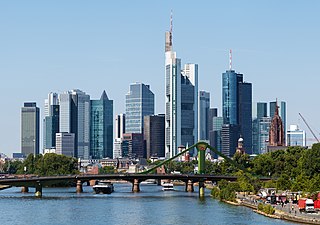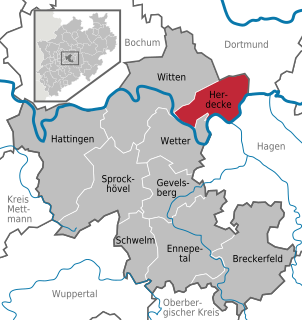
Aalen is a former Free Imperial City located in the eastern part of the German state of Baden-Württemberg, about 70 kilometres (43 mi) east of Stuttgart and 48 kilometres (30 mi) north of Ulm. It is the seat of the Ostalbkreis district and is its largest town. It is also the largest town in the Ostwürttemberg region. Since 1956, Aalen has had the status of Große Kreisstadt. It is noted for its many half-timbered houses constructed from the 16th century through the 18th century.

Frankfurt, officially Frankfurt am Main, is the most populous city in the German state of Hesse. Its 763,380 inhabitants as of 31 December 2019 make it the fifth-most populous city in Germany. On the river Main, it forms a continuous conurbation with the neighboring city of Offenbach am Main and its urban area has a population of 2.3 million. The city is the heart of the larger Rhine-Main Metropolitan Region, which has a population of 5.5 million and is Germany's second-largest metropolitan region after the Rhine-Ruhr Region. Frankfurt's central business district lies about 90 km (56 mi) northwest of the geographic center of the EU at Gadheim, Lower Franconia. Like France and Franconia, the city is named after the Franks. Frankfurt is the largest city in the Rhine Franconian dialect area.

Augsburg is a city in Swabia, Bavaria, Germany, around 50 km west of Bavarian capital Munich. It is a university town and regional seat of the Regierungsbezirk Schwaben with an impressive Altstadt. Augsburg is an urban district and home to the institutions of the Landkreis Augsburg. It is the third-largest city in Bavaria with a population of 300,000 inhabitants, with 885,000 in its metropolitan area.

Tchintabaraden is a town and commune located in the Azawagh area of Niger, in the north of the Tahoua Region.It is the capital of the region's Tchintabaraden Department. It is the market center for the Iwillimidan Tuareg. The first insurrectionist movement for the autonomy of Tenere, the Tuareg region in central-north and western Niger, began here and in nearby Abalagh in 1985. In the neighboring oasis of In-Gall, the Cure Salee, or "the festival of the nomads", is held annually.

Herdecke is a town in the district of Ennepe-Ruhr-Kreis, North Rhine-Westphalia in Germany. It is located south of Dortmund in the Ruhr Area. Its location between the two Ruhr reservoirs Hengsteysee and Harkortsee has earned it the nickname Die Stadt zwischen den Ruhrseen.
The Battle of Zusmarshausen was fought on 17 May 1648 between Bavarian-Imperial forces under von Holzappel and an allied Franco-Swedish army under the command of Turenne in the modern Augsburg district of Bavaria, Germany. The allied force emerged victorious, and the Imperial army was only rescued from annihilation by the stubborn rearguard fighting of Raimondo Montecuccoli and his cavalry.

The New Town Hall is a town hall at the northern part of Marienplatz in Munich, Bavaria, Germany. It hosts the city government including the city council, offices of the mayors and a small portion of the administration. In 1874 the municipality had left the Old Town Hall for its new domicile.

Mary, Untier of Knots or Mary, Undoer of Knots is the name of both a Marian devotion and a Baroque painting which represents that devotion. The painting by Johann Georg Melchior Schmidtner, of around 1700, is in the Catholic pilgrimage church of St. Peter am Perlach, otherwise known as the Perlach church, in Augsburg, Bavaria, Germany. Pope Francis saw the image while in Germany as a student and promoted her veneration in Latin America.

Turamichele ("Tower-Michael") is the name of a moving mechanical figure on the Perlach Tower (Perlachturm) next to Perlach church in Augsburg, Bavaria, Germany. It shows the Archangel Michael fighting with the devil. Every year on 29 September the Turamichele appears in a window on the west side of the tower. The day is also marked by a big children's party.
Bärenkeller is one of the seventeen highest level civic divisions, or Planungsräume, of the city of Augsburg, Bavaria, Germany. It is located in the northwestern portion of the city and consists of only one Stadtbezirk, or ward, 23 Bärenkeller, with which it is coterminous. As of January 1, 2006, 7,360 people reside in Bärenkeller, which has an area of 2.99 km2 (1.15 mi2).

Inningen is one of the 17 Planungsräume of Augsburg, Bavaria, Germany. It consists solely of the 41st Stadtbezirk, with which it shares a name and is coterminous. As of January 1, 2006, Inningen was reported to have a population 4,735, and an area of 13.42 km2 (5.18 km2). Its population density is 352.8 persons per square kilometer. It was previously its own municipality before being annexed to Augsburg in 1972.

Le Vésinet–Le Pecq is a railway station in Le Vésinet, France, built in 1972, on the A1 branch of the Paris Region RER commuter rail line A. It primarily serves the communities of Le Vésinet, Le Pecq, and southern Montesson in the western suburbs of Paris.

The Cathedral of Augsburg is a Roman Catholic church in Augsburg, Bavaria, Germany, founded in the 11th century in Romanesque style, but with 14th-century Gothic additions. Together with the Basilica of St. Ulrich and Afra, it is one of the city's main attractions. It measures 113 x 40 m, and its towers are 62 m high. It is dedicated to the Visitation of Virgin Mary.

St. Peter am Perlach or Perlach-Church is a romanesque Catholic church in the center of Augsburg (Bavaria). The tower of the church, the Perlachturm is together with the Augsburg Town Hall the landmark of Augsburg.

The Catholic Holy Cross Church is a Roman Catholic parish church in the southern German city of Augsburg, Bavaria. While its history dates back to 1143 when a hospice with a chapel was constructed on the site, the present church in the Gothic style was built by Provost Vitus Fackler in 1508. After bombing damage in the Second World War, rebuilding work was completed in 1949.

The Bremer Marktplatz is a square situated in the centre of the Hanseatic City of Bremen. One of the oldest public squares in the city, it covers an area of 3,484 m2 (37,500 sq ft). It is no longer used as a market place except for the Christmas market and the annual Freimarkt Fair at the end of October.

The Staatstheater Augsburg is a theatre of Augsburg, Germany. Until 1999 it was called Städtische Bühnen Augsburg, from then until the end of August 2018 it was called Theater Augsburg. It offers on four stages musical theatre, plays and ballet, with its own choir and the orchestra Augsburg Philharmonic.

Maria Rosenkranzkönigin (English: "Our Lady of the Rosary" is a Roman Catholic parish church in the municipality of Neubiberg, near in Bavaria. The church was built in 1928 using functional-modern forms of architecture. It was consecrated on November 11, 1928 by Michael Cardinal von Faulhaber.

Neuperlach is a borough in the southeast of the Bavarian capital, Munich. and is part of the city district no. 16, Ramersdorf-Perlach. It was built starting in 1967 east of the former village of Perlach on the ground of the former Perlacher Haid. Neuperlach is located east of the boroughs Ramersdorf and Perlach, south of the city districts no. 14 and no. 15 (Trudering-Riem), west of the borough Waldperlach and north of Unterbiberg. The borough encompasses multiplehousing estates, including several high-rise estates, and is one of Germany's biggest satellite towns. In the center of Neuperlach the large pep shopping mall is located, one of the most profitable shopping centers in Germany. The Hachinger Bach runs through the western part of Neuperlach from north to south. The stream also passes through the western part of the Ostpark.

Ramersdorf-Perlach is a borough of Munich. It is located south-east of the city center and is the most populous of Munich's boroughs with a population of about 116,000.






















